Occupational Therapy and Lactation: treatment mastitis, milk bleb treatment, mental health, oral motor therapy, infant therapy (2023)

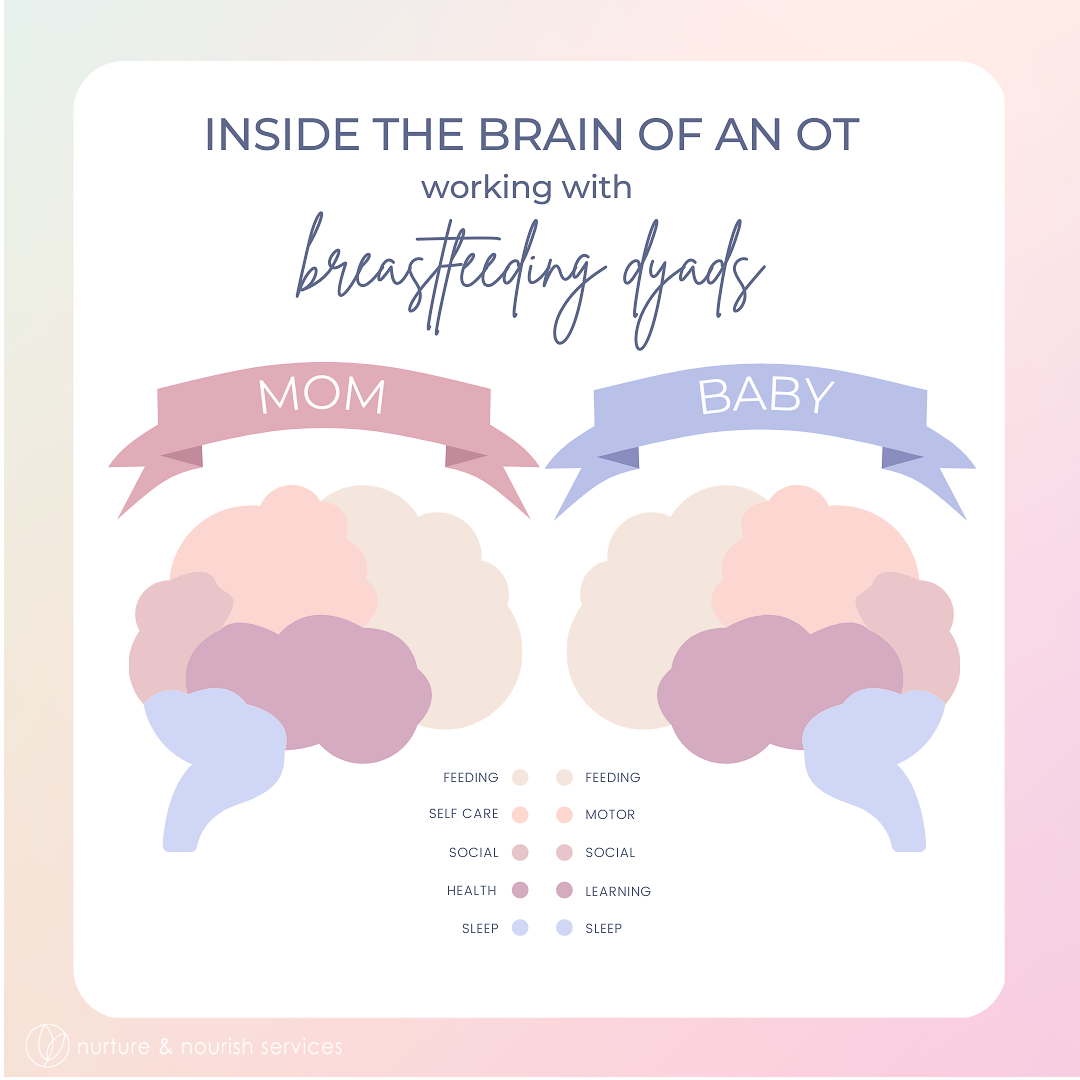
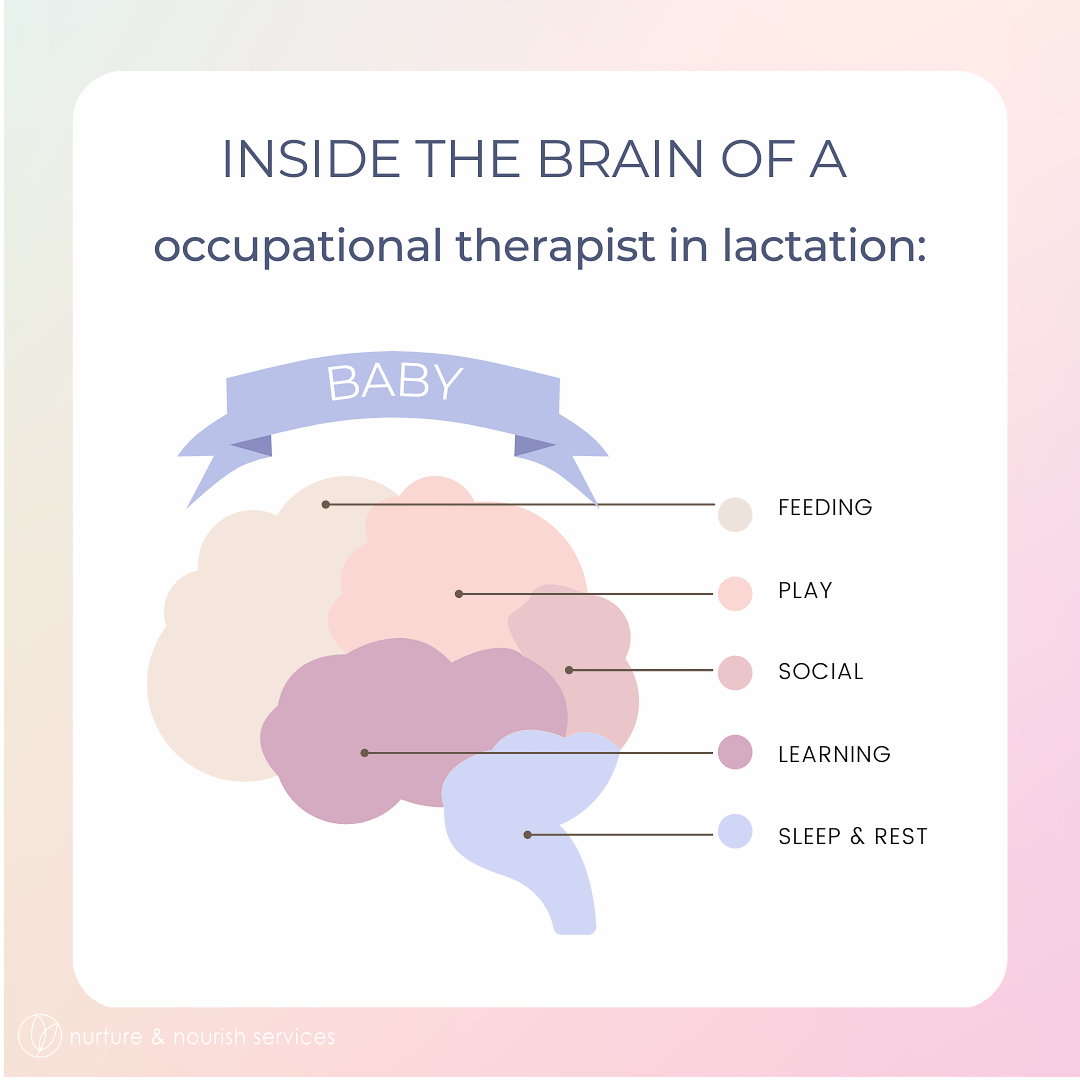
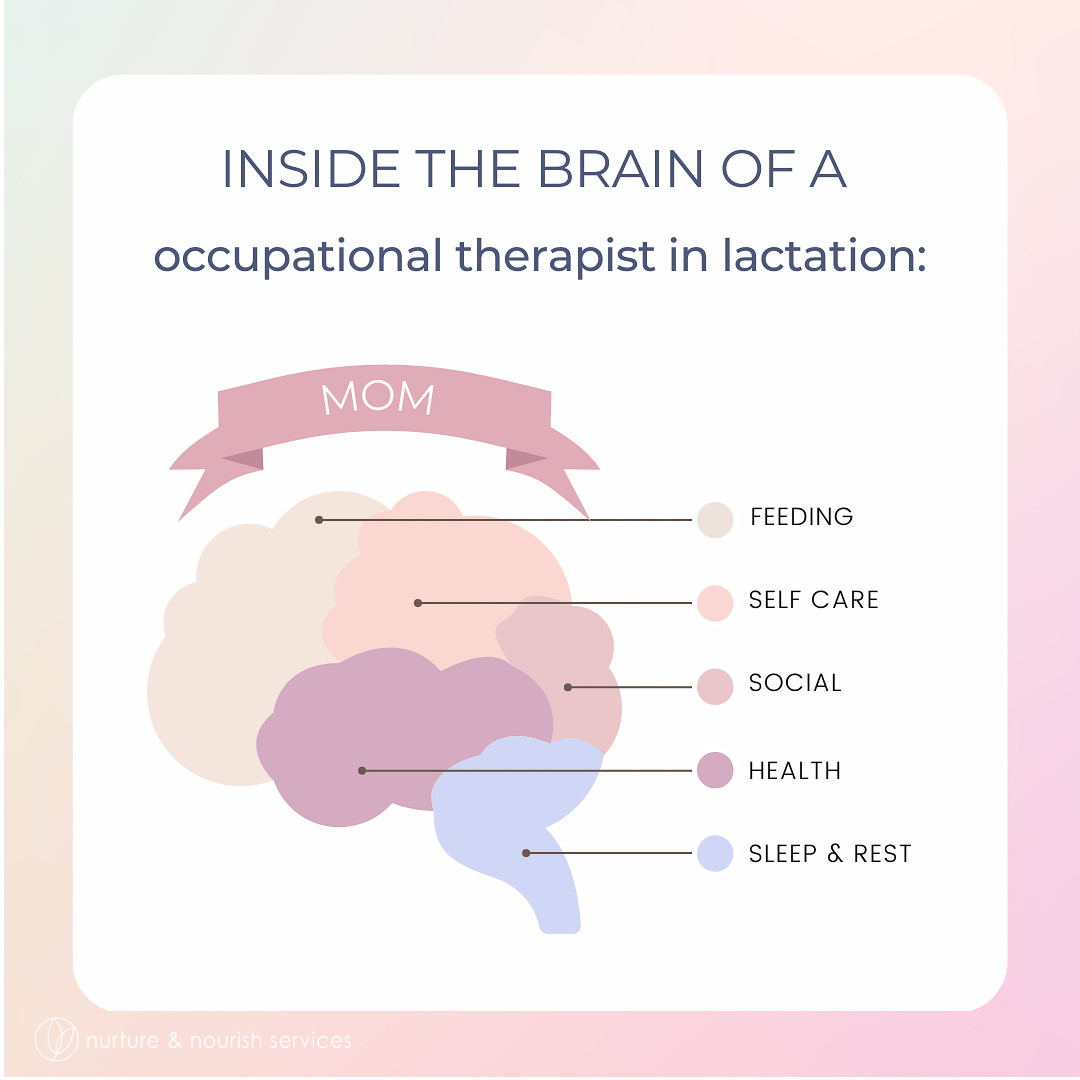
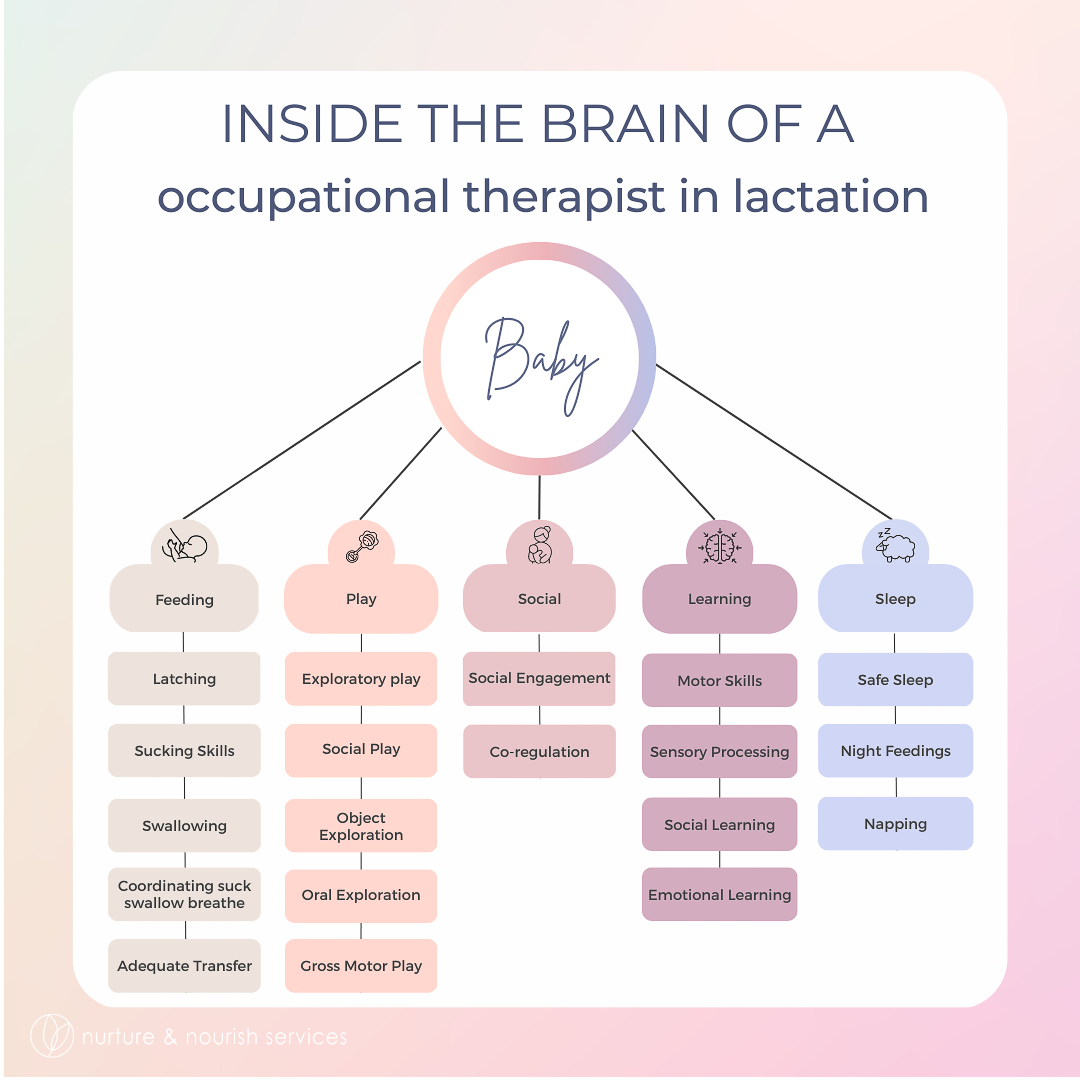
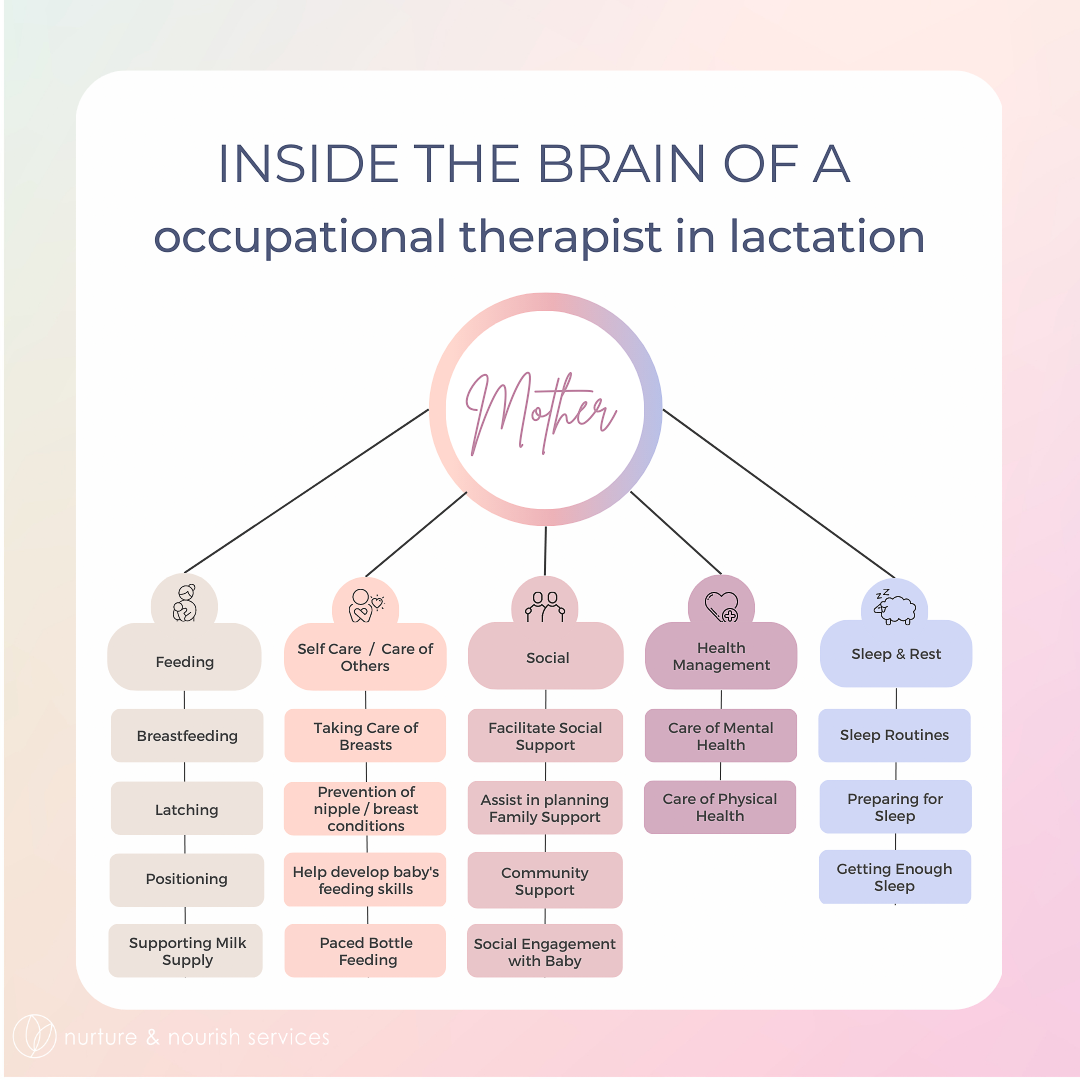
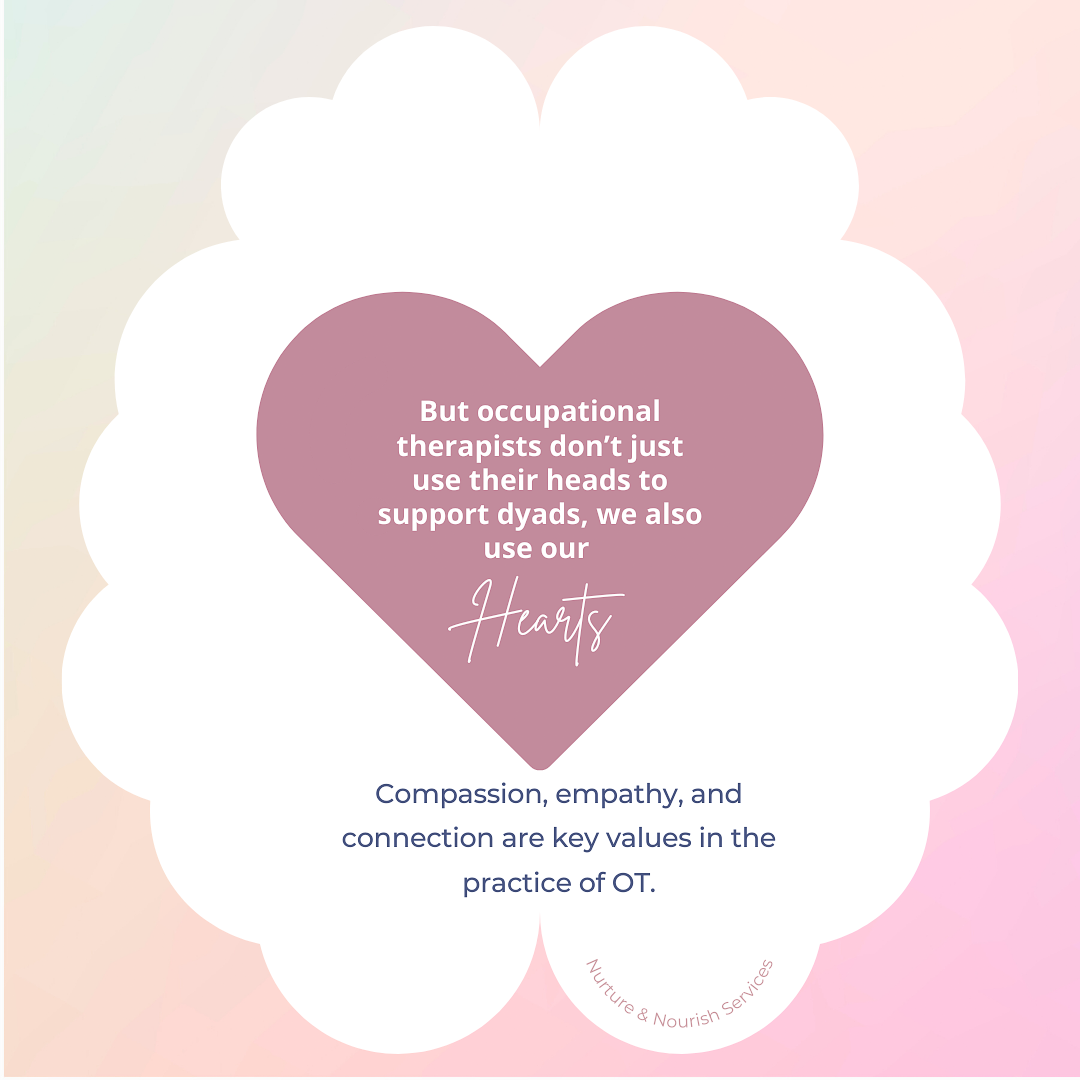
Occupational Therapy and Breastfeeding
Occupational therapy is a profession with a unique approach to working with breastfeeding dyads. Breastfeeding is a profoundly intimate and complex journey shared between a mother and her baby, where the connection goes beyond just nourishment. However, this beautiful bond can sometimes face challenges, and that's where occupational therapists can support them. These healthcare professionals bring a holistic approach to the table, treating breastfeeding dyads (the mother-baby pair) as a unit rather than isolated individuals. In this post, we'll explore how occupational therapists work their magic by treating breastfeeding dyads holistically. We also see the connection between a person's, mind and body. This means that when working with breastfeeding dyads, we can address the breastfeeding parent as a whole and the baby as a whole.
One of the primary goals that OTs address is helping people engage in the activities or "occupations" that they want to, or need to participate in. In this post, I share some of the "occupations" that OTs provide support for when working with breastfeeding dyads. You may be asking "what is an occupation?" In the field of OT, we define occupations as anything that keeps you occupied and brings meaning or purpose to life.
Understanding Holistic Care
Holistic care in the context of breastfeeding dyads means looking beyond the surface issues and considering the entirety of the mother-baby dyad, taking into account physical, emotional, and environmental factors that may affect their breastfeeding journey.
Physical Assessment and Intervention
Occupational therapists conduct a thorough assessment of both the mother and the baby. They evaluate:
Maternal physical health: This includes assessing any physical discomfort or pain the mother may be experiencing during breastfeeding, such as nipple pain, engorgement, or musculoskeletal issues. Occupational therapists play a crucial role in addressing mastitis through innovative therapeutic interventions, including massage and therapeutic ultrasound. These skilled professionals utilize their expertise to develop personalized treatment plans that focus on relieving the discomfort associated with mastitis, a common condition affecting breastfeeding mothers. Through targeted massage techniques, occupational therapists can promote lymphatic drainage, reduce inflammation, and enhance overall breast health. Additionally, the integration of therapeutic ultrasound adds a cutting-edge dimension to their approach, as it helps to alleviate pain and inflammation while accelerating the healing process.
Baby's oral motor skills:
Occupational therapists play a vital role in optimizing oral motor function in infants through specialized interventions designed to promote healthy feeding and development. By employing a holistic approach, these skilled professionals assess and address various aspects of oral motor skills, such as sucking, swallowing, and overall oral coordination. Through gentle and purposeful techniques, occupational therapists guide parents and caregivers in facilitating proper muscle movements in an infant's mouth, fostering a foundation for successful breastfeeding and eating. Their expertise extends to identifying and addressing any challenges related to tongue and lip mobility, jaw stability, and sensory processing, ensuring a well-rounded intervention. Occupational therapists also collaborate with families to create individualized plans that may include exercises, sensory stimulation, and positioning techniques. Emphasizing early intervention and family-centered care, occupational therapists make a significant impact on infants' oral motor development, promoting a healthy start in their journey of growth and nourishment.Positioning and latch: Occupational therapists educate mothers on proper positioning techniques to ensure a comfortable and effective latch, taking into consideration both the mother's and baby's physical needs.
Emotional Support and Mental Well-being
Breastfeeding is not just a physical act; it also involves significant emotional components for both the mother and baby. Occupational therapists provide:
Emotional support: They offer mothers a safe space to express their feelings and concerns about breastfeeding, addressing any anxiety, stress, or emotional challenges they may be facing.
Infant-parent bonding: Occupational therapists help parents understand their baby's cues and emotional needs, fostering a strong emotional connection between the mother and baby.
Environmental Factors
A holistic approach also considers the environment in which breastfeeding takes place:
Feeding environment: Therapists assess the comfort and functionality of the space where breastfeeding occurs, suggesting modifications if necessary to create a relaxing and conducive atmosphere.
Support system: Occupational therapists work with families to ensure a supportive network is in place, which can include partners, family members, or friends who understand the importance of breastfeeding and can provide assistance and encouragement.
Collaboration with Healthcare Professionals
Occupational therapists work collaboratively with other healthcare professionals involved in the mother and baby's care, such as lactation consultants, pediatricians, and speech therapists. This teamwork ensures that all aspects of lactation are addressed comprehensively.
Conclusion
Occupational therapists approach breastfeeding dyads with a holistic mindset, recognizing that the journey encompasses more than just the physical act of feeding. They consider the physical, emotional, and environmental aspects of both the mother and baby to provide comprehensive care. By addressing physical discomfort, supporting emotional well-being, and optimizing the environment, occupational therapists empower breastfeeding dyads to overcome challenges and create a nurturing and successful breastfeeding experience. Through their holistic approach, these healthcare professionals play a vital role in helping mothers and babies build a strong and enduring bond.
Occupational therapists use their minds to help their clients participate in occupations, but we also use our hearts to support them. Compassion, empathy, and connection are key values in the practice of OT.
copyright © 2022 Nurture and Nourish ServicesCheck out more from the blog
Learn about Infant OT
Infant Occupational Therapy: a Holistic Approach
Archive
-
Bodywork for Babies
- May 27, 2023 Craniosacral Therapy for Tongue Tie (2024) May 27, 2023
- Nov 5, 2022 Bodywork Massage for Babies: Craniosacral, Craniosacral Fascial Therapy (CFT), Chiropractic, Osteopathy, and more. (2024) Nov 5, 2022
-
Bottle feeding
- May 3, 2024 Getting Baby Back to Breast May 3, 2024
- Apr 29, 2024 Colic Baby: Signs, Symptoms, and Relief Apr 29, 2024
- Jan 11, 2024 What kind of bottle is best for your baby? (2024) Jan 11, 2024
- Jul 1, 2023 Mom Support Group: Circle Moms at Gala Desserts Jul 1, 2023
- Jun 3, 2023 How Much Breastmilk Should a Newborn Eat (2024) Jun 3, 2023
- Jan 29, 2023 Bottle Refusal (2024) Jan 29, 2023
- Dec 7, 2022 New Pinterest Page Dec 7, 2022
- Nov 23, 2022 Signs your newborn is hungry (2023) Nov 23, 2022
- Oct 28, 2022 Storing and Preparing Breastmilk: CDC Guidelines (2023) Oct 28, 2022
- Sep 9, 2022 Bottle Feeding your Breastfed Baby: Paced feeding, newborn feeding, bottle nipples, bottle feeding tips (2024) Sep 9, 2022
-
Breastfeeding
- May 3, 2024 Getting Baby Back to Breast May 3, 2024
- Apr 29, 2024 Colic Baby: Signs, Symptoms, and Relief Apr 29, 2024
- Sep 8, 2023 Latina Lactation Support Sep 8, 2023
- Jul 1, 2023 Mom Support Group: Circle Moms at Gala Desserts Jul 1, 2023
- Jun 3, 2023 How Much Breastmilk Should a Newborn Eat (2024) Jun 3, 2023
- May 28, 2023 How many diapers does a newborn use a day? (2024) May 28, 2023
- May 11, 2023 Tongue Tie and Breastfeeding (2023) May 11, 2023
- May 9, 2023 Tongue Tie Symptoms in Newborns: Colic, Reflux, Gas (2024) May 9, 2023
- Apr 3, 2023 Newborn Nursing: Latch, Colostrum, Torticollis, Sleepy Babies, Milk Supply, and More (2023) Apr 3, 2023
- Mar 19, 2023 Infant Occupational Therapy: a Holistic Approach (2024) Mar 19, 2023
- Jan 24, 2023 Breastfeeding Tools: Nipple Shields, Pacifiers, and Breast Pumps (2023) Jan 24, 2023
- Jan 19, 2023 Occupational Therapy and Lactation: treatment mastitis, milk bleb treatment, mental health, oral motor therapy, infant therapy (2023) Jan 19, 2023
- Jan 4, 2023 6 Month Milestones Jan 4, 2023
- Dec 26, 2022 Nursing Station (2023) Dec 26, 2022
- Dec 23, 2022 Foods that Decrease Milk Supply Dec 23, 2022
- Dec 11, 2022 4 Month Milestones Dec 11, 2022
- Dec 7, 2022 New Pinterest Page Dec 7, 2022
- Nov 29, 2022 Signs of a “bad latch” Nov 29, 2022
- Nov 28, 2022 How to Increase Breast Milk Supply (2023) Nov 28, 2022
- Nov 23, 2022 Signs your newborn is hungry (2023) Nov 23, 2022
- Nov 21, 2022 Get the Optimal Latch Guide Nov 21, 2022
- Nov 19, 2022 How to become an IBCLC for OTs, SLPs, or PTs (2023) Nov 19, 2022
- Nov 14, 2022 Signs your newborn is hungry- Early feeding cues Nov 14, 2022
- Nov 3, 2022 Baby milestones by month Nov 3, 2022
- Oct 28, 2022 Storing and Preparing Breastmilk: CDC Guidelines (2023) Oct 28, 2022
- Oct 21, 2022 What makes me different? Oct 21, 2022
- Oct 21, 2022 Feeding is a whole body activity Oct 21, 2022
- Oct 10, 2022 Now offering pediatric scale rentals Oct 10, 2022
- Sep 7, 2022 Nipple pain, Ouch! Sep 7, 2022
- Sep 5, 2022 What causes painful breastfeeding? Sep 5, 2022
- Aug 26, 2022 Breastfeeding Newborn Tips - Latch and Positioning (2024) Aug 26, 2022
- Aug 22, 2022 Did you know that you might be pumping with the wrong sized flanges? Aug 22, 2022
- Aug 2, 2022 Celebrating World Breastfeeding week! Aug 2, 2022
-
Charleston, SC
- Apr 29, 2024 Colic Baby: Signs, Symptoms, and Relief Apr 29, 2024
- Sep 8, 2023 Latina Lactation Support Sep 8, 2023
- Aug 14, 2023 Craniosacral Fascial Therapy for Colic, Reflux, and Sleep (2024) Aug 14, 2023
- Apr 12, 2023 Mommy and Me Class Apr 12, 2023
- Apr 3, 2023 Newborn Nursing: Latch, Colostrum, Torticollis, Sleepy Babies, Milk Supply, and More (2023) Apr 3, 2023
- Dec 18, 2022 Occupational Therapy for Tongue Tie (2023) Dec 18, 2022
-
Craniosacral therapy
- Aug 14, 2023 Craniosacral Fascial Therapy for Colic, Reflux, and Sleep (2024) Aug 14, 2023
- Jun 10, 2023 Tongue Tie Therapy: A Whole Body Approach (2024) Jun 10, 2023
- May 27, 2023 Craniosacral Therapy for Tongue Tie (2024) May 27, 2023
- May 7, 2023 Tongue Tie Release: Oral Tie Surgery, Therapy, and Specialists (2024) May 7, 2023
- Mar 19, 2023 Infant Occupational Therapy: a Holistic Approach (2024) Mar 19, 2023
- Nov 29, 2022 Nurture & Nourish Services can help with Nov 29, 2022
- Nov 10, 2022 Infant Craniosacral Therapy Nov 10, 2022
- Nov 5, 2022 Bodywork Massage for Babies: Craniosacral, Craniosacral Fascial Therapy (CFT), Chiropractic, Osteopathy, and more. (2024) Nov 5, 2022
- Oct 21, 2022 What makes me different? Oct 21, 2022
- Oct 17, 2022 Follow me on IG Oct 17, 2022
- Aug 3, 2022 Infant Craniosacral Therapy Aug 3, 2022
-
Infant Feeding
- May 11, 2023 Tongue Tie and Breastfeeding (2023) May 11, 2023
- May 1, 2023 Tongue Tie (2023) May 1, 2023
- Mar 19, 2023 Infant Occupational Therapy: a Holistic Approach (2024) Mar 19, 2023
- Jan 29, 2023 Bottle Refusal (2024) Jan 29, 2023
- Nov 30, 2022 Baby Led Weaning Nov 30, 2022
- Aug 25, 2022 New Lactation Office in North Mount Pleasant Aug 25, 2022
-
Lactation
- Sep 8, 2023 Latina Lactation Support Sep 8, 2023
- Jun 3, 2023 How Much Breastmilk Should a Newborn Eat (2024) Jun 3, 2023
- May 28, 2023 How many diapers does a newborn use a day? (2024) May 28, 2023
- May 11, 2023 Tongue Tie and Breastfeeding (2023) May 11, 2023
- May 9, 2023 Tongue Tie Symptoms in Newborns: Colic, Reflux, Gas (2024) May 9, 2023
- Apr 3, 2023 Newborn Nursing: Latch, Colostrum, Torticollis, Sleepy Babies, Milk Supply, and More (2023) Apr 3, 2023
- Jan 24, 2023 Breastfeeding Tools: Nipple Shields, Pacifiers, and Breast Pumps (2023) Jan 24, 2023
- Jan 23, 2023 The Lactation Network Jan 23, 2023
- Jan 19, 2023 Occupational Therapy and Lactation: treatment mastitis, milk bleb treatment, mental health, oral motor therapy, infant therapy (2023) Jan 19, 2023
- Dec 26, 2022 Nursing Station (2023) Dec 26, 2022
- Dec 23, 2022 Foods that Decrease Milk Supply Dec 23, 2022
- Nov 29, 2022 Nurture & Nourish Services can help with Nov 29, 2022
- Nov 28, 2022 How to Increase Breast Milk Supply (2023) Nov 28, 2022
- Nov 23, 2022 Signs your newborn is hungry (2023) Nov 23, 2022
- Nov 21, 2022 Get the Optimal Latch Guide Nov 21, 2022
- Nov 14, 2022 Signs your newborn is hungry- Early feeding cues Nov 14, 2022
- Nov 3, 2022 Baby milestones by month Nov 3, 2022
- Oct 28, 2022 Storing and Preparing Breastmilk: CDC Guidelines (2023) Oct 28, 2022
- Oct 21, 2022 What makes me different? Oct 21, 2022
- Oct 21, 2022 Feeding is a whole body activity Oct 21, 2022
- Oct 17, 2022 Follow me on IG Oct 17, 2022
- Sep 9, 2022 Bottle Feeding your Breastfed Baby: Paced feeding, newborn feeding, bottle nipples, bottle feeding tips (2024) Sep 9, 2022
- Sep 9, 2022 What I can help with Sep 9, 2022
- Sep 5, 2022 What causes painful breastfeeding? Sep 5, 2022
- Aug 26, 2022 Breastfeeding Newborn Tips - Latch and Positioning (2024) Aug 26, 2022
- Aug 25, 2022 New Lactation Office in North Mount Pleasant Aug 25, 2022
- Aug 22, 2022 Did you know that you might be pumping with the wrong sized flanges? Aug 22, 2022
- Aug 2, 2022 Celebrating World Breastfeeding week! Aug 2, 2022
- Jul 28, 2022 Becoming a lactation consultant… Jul 28, 2022
-
Lactation Consultant
- Sep 8, 2023 Latina Lactation Support Sep 8, 2023
- Jun 3, 2023 How Much Breastmilk Should a Newborn Eat (2024) Jun 3, 2023
- May 11, 2023 Tongue Tie and Breastfeeding (2023) May 11, 2023
- May 7, 2023 Tongue Tie Release: Oral Tie Surgery, Therapy, and Specialists (2024) May 7, 2023
- May 1, 2023 Tongue Tie (2023) May 1, 2023
- Jan 23, 2023 The Lactation Network Jan 23, 2023
- Dec 26, 2022 Nursing Station (2023) Dec 26, 2022
- Dec 23, 2022 Foods that Decrease Milk Supply Dec 23, 2022
- Dec 7, 2022 New Pinterest Page Dec 7, 2022
- Nov 28, 2022 How to Increase Breast Milk Supply (2023) Nov 28, 2022
- Nov 21, 2022 Get the Optimal Latch Guide Nov 21, 2022
- Nov 19, 2022 How to become an IBCLC for OTs, SLPs, or PTs (2023) Nov 19, 2022
- Nov 14, 2022 Signs your newborn is hungry- Early feeding cues Nov 14, 2022
- Oct 31, 2022 Office in Mount Pleasant Oct 31, 2022
- Oct 28, 2022 Storing and Preparing Breastmilk: CDC Guidelines (2023) Oct 28, 2022
- Oct 21, 2022 What makes me different? Oct 21, 2022
- Oct 17, 2022 Follow me on IG Oct 17, 2022
- Oct 10, 2022 Now offering pediatric scale rentals Oct 10, 2022
- Sep 9, 2022 Bottle Feeding your Breastfed Baby: Paced feeding, newborn feeding, bottle nipples, bottle feeding tips (2024) Sep 9, 2022
- Sep 9, 2022 What I can help with Sep 9, 2022
- Sep 5, 2022 What causes painful breastfeeding? Sep 5, 2022
- Aug 26, 2022 Breastfeeding Newborn Tips - Latch and Positioning (2024) Aug 26, 2022
- Aug 25, 2022 New Lactation Office in North Mount Pleasant Aug 25, 2022
- Aug 22, 2022 Did you know that you might be pumping with the wrong sized flanges? Aug 22, 2022
- Aug 2, 2022 Celebrating World Breastfeeding week! Aug 2, 2022
- Jul 28, 2022 Becoming a lactation consultant… Jul 28, 2022
-
Milestones
- Mar 19, 2023 Infant Occupational Therapy: a Holistic Approach (2024) Mar 19, 2023
- Feb 9, 2023 12 Month Milestones Feb 9, 2023
- Jan 26, 2023 9 month milestones Jan 26, 2023
- Jan 23, 2023 8 month milestones Jan 23, 2023
- Jan 12, 2023 7 month milestones Jan 12, 2023
- Jan 4, 2023 6 Month Milestones Jan 4, 2023
- Dec 28, 2022 5 month milestones Dec 28, 2022
- Dec 11, 2022 4 Month Milestones Dec 11, 2022
- Dec 7, 2022 New Pinterest Page Dec 7, 2022
- Nov 3, 2022 Baby milestones by month Nov 3, 2022
- Oct 21, 2022 Feeding is a whole body activity Oct 21, 2022
-
Mount Pleasant
- Jul 1, 2023 Mom Support Group: Circle Moms at Gala Desserts Jul 1, 2023
- Apr 12, 2023 Mommy and Me Class Apr 12, 2023
-
Mt Pleasant SC
- May 27, 2023 Craniosacral Therapy for Tongue Tie (2024) May 27, 2023
-
Newborns
- Apr 29, 2024 Colic Baby: Signs, Symptoms, and Relief Apr 29, 2024
- Jul 1, 2023 Mom Support Group: Circle Moms at Gala Desserts Jul 1, 2023
- Jun 3, 2023 How Much Breastmilk Should a Newborn Eat (2024) Jun 3, 2023
- May 28, 2023 How many diapers does a newborn use a day? (2024) May 28, 2023
- May 9, 2023 Tongue Tie Symptoms in Newborns: Colic, Reflux, Gas (2024) May 9, 2023
- Apr 3, 2023 Newborn Nursing: Latch, Colostrum, Torticollis, Sleepy Babies, Milk Supply, and More (2023) Apr 3, 2023
- Nov 29, 2022 Signs of a “bad latch” Nov 29, 2022
- Nov 28, 2022 How to Increase Breast Milk Supply (2023) Nov 28, 2022
- Nov 23, 2022 Signs your newborn is hungry (2023) Nov 23, 2022
- Nov 14, 2022 Signs your newborn is hungry- Early feeding cues Nov 14, 2022
- Oct 28, 2022 Storing and Preparing Breastmilk: CDC Guidelines (2023) Oct 28, 2022
- Sep 9, 2022 Bottle Feeding your Breastfed Baby: Paced feeding, newborn feeding, bottle nipples, bottle feeding tips (2024) Sep 9, 2022
- Sep 5, 2022 What causes painful breastfeeding? Sep 5, 2022
- Aug 26, 2022 Breastfeeding Newborn Tips - Latch and Positioning (2024) Aug 26, 2022
-
Nurture and Nourish Charleston
- Jan 11, 2024 What kind of bottle is best for your baby? (2024) Jan 11, 2024
- Jul 1, 2023 Mom Support Group: Circle Moms at Gala Desserts Jul 1, 2023
- Mar 20, 2023 Free Mommy and Me Class! - SOLD OUT (2022) Mar 20, 2023
- Nov 1, 2022 Nurture & Nourish - New Digital Business Cards Nov 1, 2022
- Oct 31, 2022 Office in Mount Pleasant Oct 31, 2022
- Oct 21, 2022 What makes me different? Oct 21, 2022
- Oct 17, 2022 Follow me on IG Oct 17, 2022
- Sep 9, 2022 What I can help with Sep 9, 2022
- Sep 7, 2022 Nipple pain, Ouch! Sep 7, 2022
- Sep 5, 2022 What causes painful breastfeeding? Sep 5, 2022
- Aug 25, 2022 New Lactation Office in North Mount Pleasant Aug 25, 2022
-
Nurture and Nourish Services
- Sep 8, 2023 Latina Lactation Support Sep 8, 2023
- Apr 12, 2023 Mommy and Me Class Apr 12, 2023
- Dec 18, 2022 Occupational Therapy for Tongue Tie (2023) Dec 18, 2022
-
Occupational Therapy
- Jun 10, 2023 Tongue Tie Therapy: A Whole Body Approach (2024) Jun 10, 2023
- May 7, 2023 Tongue Tie Release: Oral Tie Surgery, Therapy, and Specialists (2024) May 7, 2023
- May 1, 2023 Tongue Tie (2023) May 1, 2023
- Mar 20, 2023 Free Mommy and Me Class! - SOLD OUT (2022) Mar 20, 2023
- Mar 19, 2023 Infant Occupational Therapy: a Holistic Approach (2024) Mar 19, 2023
- Jan 29, 2023 Bottle Refusal (2024) Jan 29, 2023
- Jan 19, 2023 Occupational Therapy and Lactation: treatment mastitis, milk bleb treatment, mental health, oral motor therapy, infant therapy (2023) Jan 19, 2023
- Dec 18, 2022 Occupational Therapy for Tongue Tie (2023) Dec 18, 2022
- Dec 11, 2022 4 Month Milestones Dec 11, 2022
- Dec 7, 2022 New Pinterest Page Dec 7, 2022
- Nov 30, 2022 Baby Led Weaning Nov 30, 2022
- Nov 29, 2022 Nurture & Nourish Services can help with Nov 29, 2022
- Nov 19, 2022 How to become an IBCLC for OTs, SLPs, or PTs (2023) Nov 19, 2022
- Nov 10, 2022 Infant Craniosacral Therapy Nov 10, 2022
- Nov 3, 2022 Baby milestones by month Nov 3, 2022
- Nov 1, 2022 Nurture & Nourish - New Digital Business Cards Nov 1, 2022
- Oct 31, 2022 Office in Mount Pleasant Oct 31, 2022
- Oct 21, 2022 What makes me different? Oct 21, 2022
- Oct 21, 2022 Feeding is a whole body activity Oct 21, 2022
- Sep 27, 2022 Have you heard of baby-led weaning Sep 27, 2022
- Sep 9, 2022 Bottle Feeding your Breastfed Baby: Paced feeding, newborn feeding, bottle nipples, bottle feeding tips (2024) Sep 9, 2022
- Sep 9, 2022 What I can help with Sep 9, 2022
- Aug 25, 2022 New Lactation Office in North Mount Pleasant Aug 25, 2022
- Aug 3, 2022 Infant Craniosacral Therapy Aug 3, 2022
- Jul 29, 2022 Pediatric craniosacral therapy in Mount Pleasant, SC! Jul 29, 2022
- Jul 28, 2022 Becoming a lactation consultant… Jul 28, 2022
-
Tongue-tie
- Aug 14, 2023 Craniosacral Fascial Therapy for Colic, Reflux, and Sleep (2024) Aug 14, 2023
- Jun 10, 2023 Tongue Tie Therapy: A Whole Body Approach (2024) Jun 10, 2023
- May 27, 2023 Craniosacral Therapy for Tongue Tie (2024) May 27, 2023
- May 11, 2023 Tongue Tie and Breastfeeding (2023) May 11, 2023
- May 9, 2023 Tongue Tie Symptoms in Newborns: Colic, Reflux, Gas (2024) May 9, 2023
- May 7, 2023 Tongue Tie Release: Oral Tie Surgery, Therapy, and Specialists (2024) May 7, 2023
- May 1, 2023 Tongue Tie (2023) May 1, 2023
- Dec 18, 2022 Occupational Therapy for Tongue Tie (2023) Dec 18, 2022
- Nov 29, 2022 Signs of a “bad latch” Nov 29, 2022
- Nov 5, 2022 Bodywork Massage for Babies: Craniosacral, Craniosacral Fascial Therapy (CFT), Chiropractic, Osteopathy, and more. (2024) Nov 5, 2022
- Oct 17, 2022 Follow me on IG Oct 17, 2022
- Sep 9, 2022 What I can help with Sep 9, 2022
- Sep 5, 2022 What causes painful breastfeeding? Sep 5, 2022
- Aug 25, 2022 New Lactation Office in North Mount Pleasant Aug 25, 2022
- Aug 3, 2022 Infant Craniosacral Therapy Aug 3, 2022
-
Whole Body Therapy
- Aug 14, 2023 Craniosacral Fascial Therapy for Colic, Reflux, and Sleep (2024) Aug 14, 2023
- Jun 10, 2023 Tongue Tie Therapy: A Whole Body Approach (2024) Jun 10, 2023
-
breastmilk
- Jan 11, 2024 What kind of bottle is best for your baby? (2024) Jan 11, 2024

